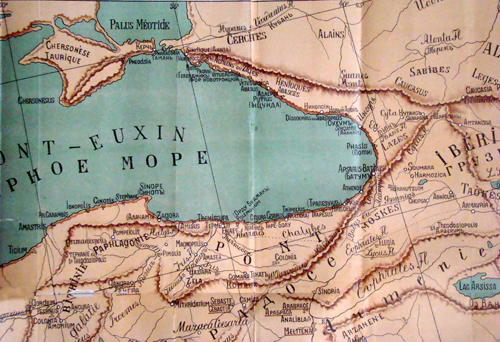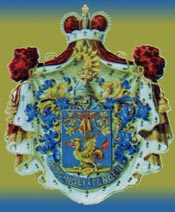
The Black Sea Region
Samegrelo is bordered to the west by the Black Sea, one of Eurasia’s great bodies of water. The region surrounding the Sea has historically been a cauldron of clashing religions, cultures, and linguistic groups, and it continues to suffer from such tensions to this day. A recurring theme in the region has been the struggle of small political entities (such as Samegrelo) based on indigenous tribes, family dynasties, or minor linguistic groups to protect their identities in the face of encroachment by much more powerful neighbors such as the empires of Russia, Turkey, Byzantium, and Persia. Another important historical theme has been the Black Sea as a conduit for connecting Europe to the East.
 |
Geography and Geology
The Black Sea is linked to the Atlantic Ocean via the Bosporus Strait, the Sea of Marmara, the Dardanelles Strait, and the Aegean and Mediterranean Seas. With a surface area of 461,000 square kilometers (178,000 square miles), the Black Sea is slightly larger than its landlocked neighbor, the Caspian Sea, and about twice as deep at its maximum depth—2,210 meters (7,250 feet). It is bordered today by the Ukraine to the north, Russia to the northeast, Georgia to the east, Turkey to the south, and Bulgaria and Romania to the west.
Two climatic zones meet in the region of the Black Sea. To the north, a steppe climate prevails, with cold winters and dry summers. To the south, the climate is subtropical, with abundant rain, mild winters, and humid summers. Where these two climatic zones run up against each other, the results are the high winds and erratic currents that Black Sea sailors have long dreaded.
Despite a continuous flow of water between the Black Sea and the Mediterranean, scientists believe that the Black Sea is biologically dead in its lower depths, due to weak ventilation. The bottom of the sea consists of black sludge, seething with hydrogen sulfide—a noxious stew that is constantly replenished by dead plant and animal matter sinking down from above.
Archaeology
Although extensive underwater archaeological expeditions of the Black Sea have not been undertaken, the spread of advanced technologies such as Global Positioning Systems (GPS) and new generations of robots are likely to result in significant future discoveries. A taste of the possible treasures that lie in wait came in the late 1990s, when Robert Ballard—the legendary oceanographer and underwater archaeologist who discovered such famous wrecks as the Titanic and the Bismarck—assembled a team to explore the depths of the Black Sea off the coast of Sinope, Turkey. There, the team found the wreckage of a fifth-century, Byzantine-era ship that had sunk in an anoxic deep water zone and was remarkably well-preserved.
Another interesting find was the walls and towers of the Greek trading settlement of Dioscurias, in the shallow waters adjacent the city of Sukhumi in Abkhazia, Georgia. Dioscurias was built in the sixth century BCE, and became known as Sebastopolis under the Romans in the second century AD. In its day, it exported timber, linen, and hemp to Greece, and served as a center of the slave trade in its own region.
Trade
Possibly as early as the seventh century BCE, the Greeks established trading outposts on the eastern shores of the Black Sea that included Sinope (in modern Turkey); Phasis (at the mouth of the Rioni river in modern Georgia); Panticapaeum (present-day Kerch, in Ukraine); and the aforementioned Dioscurias. Coins and pottery from the sixth century BCE provide evidence that commercial exchanges between the Greeks and the indigenous tribes of the Black Sea region were taking place by that time, although the exact dates of Greek colonization and acculturation of the region are unknown.
In medieval times, the Black Sea provided a major link between Europe and the Islamic world. From the 9th to the 16th centuries, the Black and Caspian Seas bustled with trade between the two regions; in the late 1200s, Marco Polo returned to Europe via Constantinople following his epic visit to the Mongol court. The Black Sea trade routes carried European exports such as furs, amber, and slaves to Asia, while luxury goods such as silks, spices, perfumes, and jewelry moved in the opposite direction.
In the 15th century, trade through the region began to decrease as the Turkish Ottoman Empire, which controlled the Black Sea and much of the surrounding area at the time, began to restrict the traditional trade routes, and piracy became more of a problem. In the 18th century, however, the declining Ottoman Empire granted Russia permission to trade through the Black Sea region. Freedom of movement through the region for Russian traders was further enhanced after 1770, when the Russian navy defeated its Ottoman counterpart in a surprise attack that broke the Ottomans’ naval dominance of the Black Sea.
In the 19th century, Russia invested heavily in infrastructure around the Black Sea—including construction of a trans-Caucasian rail route—in the hope of diverting trade from the Turkish port of Trapzon to Tbilisi and the port of Poti in Samegrelo. At the end of that century, Black Sea trade experienced a boom following the discovery of oil in the Caspian Sea region to the East. The main export route for this oil involved collection in Baku, transportation by rail to Batumi, and export by ship via Poti.
Developments in the late 20th and early 21st centuries have once again made the Black Sea region an economic crossroads between Europe and the East. These include the dissolution of the Soviet Union and the rise of consumer societies in many of its successor states; Turkey’s increasing demand for raw materials as it strives to achieve Western European standards of living and gain membership in the European Union (EU); the admission of Romania and Bulgaria into the EU and NATO; an oil-fueled boom in Russia; and completion of the Baku-Tbilisi-Ceyhan pipeline to transport oil from the Caspian Sea region to the West.
[ TOP ]
